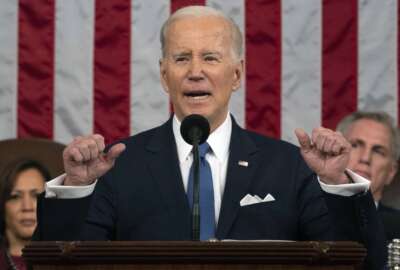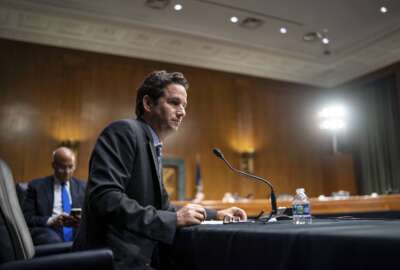Biden makes formal plans for 2024 federal pay raise
President Biden has officially recommended a 5.2% federal pay raise for most civilian employees in 2024, including a 0.5% locality pay adjustment.
President Joe Biden has officially announced plans for a federal pay raise next year, effective Jan. 1, 2024.
Most civilian employees on the General Schedule will, as expected, receive an average 5.2% pay raise in 2024, according to the alternative pay plan Biden submitted to congressional leaders Thursday afternoon.
The percentage accounts for a 4.7% across-the-board raise plus a 0.5% average locality pay adjustment, totaling a 5.2% federal pay raise.
Biden initially proposed a 5.2% average pay increase for federal employees as part of the fiscal 2024 budget request, but Thursday’s alternative pay plan is the first indication of the raise’s breakdown between a base pay increase and a locality pay adjustment.
The raise will take effect unless Congress enacts a different pay scheme for 2024. But so far, both the House and Senate’s spending packages are silent on the civilian federal pay raise, which usually indicates an endorsement of the administration’s plans.
A 5.2% raise would be the biggest pay boost for feds since the Carter administration offered up 9.1% in 1980. Federal employees received a 4.6% average pay raise at the start of 2023 and a 2.7% raise in 2022.
Biden said the 5.2% pay raise percentage will help attract, recruit and retain a skilled federal workforce.
“This alternative pay plan decision will continue to allow the federal government to employ a well‑qualified federal workforce on behalf of the American people, keeping pace with prior wage growth in the labor market,” Biden wrote.
Office of Management and Budget Deputy Director for Management Jason Miller said the administration’s approach with the 5.2% federal pay raise also aims to help agencies compete with the private sector for talent.
“Executing on the president’s planned 5.2% pay increase for military and civilian workers recognizes the federal workforce’s dedication and service on behalf of our country,” Miller said in an email statement to Federal News Network.
The planned pay raise for 2024 is an average. Some federal employees will receive slightly more and others will receive a little less than 5.2%, based on their locality pay area.
The Federal Employees Pay Comparability Act (FEPCA), a law from 1990, sets locality-based raises for most civilian feds on the General Schedule. FEPCA authorizes the funding needed to reduce the wage gap between federal and non-federal pay down to 5%. But since 1994, no presidential administration has fully adopted FEPCA.
The President can instead choose to deviate from FEPCA’s statutory formula by issuing an alternative pay plan but must inform Congress of those intentions by Aug. 31. Following the same path as Presidents for nearly 30 years, Biden has chosen to recommend an alternative plan.
Biden did not specifically point to the reason behind issuing the alternative pay plan, but notably it would cost about $19.2 billion to bring the public-private wage gap to just 5%, the President’s Pay Agent estimated. The Federal Salary Council reported that in 2022, federal workers earned 24.09% less in wages alone than non-federal colleagues — increasing from the 22.47% gap reported in 2021.
Annual federal pay raises take effect in the first pay period in January and do not become official until the president signs an executive order enacting the raise, usually near the end of the calendar year.
The alternative pay plan also falls short of the counterproposal included in the FAIR Act, a bicameral bill that Rep. Gerry Connolly (D-Va.) and Sen. Brian Schatz (D-Hawaii) introduced in January. The FAIR Act would give the civilian federal workforce an 8.7% average pay raise in 2024, divided between a 4.7% across-the-board base pay raise and a 4% average locality pay increase. The legislation also includes a 4.7% raise for prevailing rate employees. Although lawmakers have introduced the FAIR Act in some form every year for the last nine years, Congress has never passed any version of the bill.
Still, Connolly said Biden’s announcement was “great news.”
“While not quite what Senator Schatz and I called for in our FAIR Act, a 5.2% average pay raise is the highest since the Carter administration and will help us recruit and retain the federal workforce of tomorrow,” Connolly said in a press statement Thursday. “I applaud President Biden and his administration for recognizing and taking care of our nation’s greatest asset — our dedicated, patriotic federal employees.”
Federal employee unions and organizations were also quick to respond to Biden’s pay plan announcement.
“Frontline federal employees earn 24.09% less than people in similar private sector jobs … Biden’s plan would help chip away at that deficit and make federal employment more competitive,” National Treasury Employees Union National President Doreen Greenwald said in a statement. “Federal salaries have not kept pace with inflation in recent years, making it harder for employees to keep up with rising prices. And like most Americans, many of them live paycheck to paycheck.”
“This 5.2% average pay increase demonstrates the Biden administration’s understanding of the
value of these hard-working civil servants and the jobs they do, as well as displays the
administration’s commitment to recruitment and retention of talented federal employees,” said William Shackelford, national president of the National Active and Retired Federal Employees Association (NARFE).
For 2024, the Office of Personnel Management is also making plans to establish four new locality pay areas, which will take effect in January and result in slightly bigger raises for close to 33,000 federal employees in the following four localities: Fresno-Madera-Hanford, California; Reno-Fernley, Nevada; Rochester-Batavia-Seneca Falls, New York; and Spokane-Spokane Valley-Coeur d’Alene, Washington-Idaho.
Copyright © 2025 Federal News Network. All rights reserved. This website is not intended for users located within the European Economic Area.
Drew Friedman is a workforce, pay and benefits reporter for Federal News Network.
Follow @dfriedmanWFED






